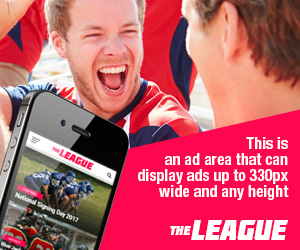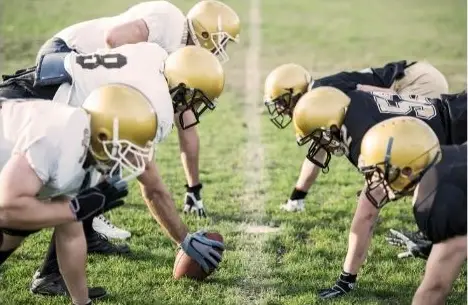
How many football positions can you name off the top of your head? Maybe 5 or 6?
Honestly, before writing this article, I knew a dozen at best. There are some that I’ve never even heard of before. But, now I know better, and so will you!
Here, you’ll learn what the positions are, along with their responsibilities and some other interesting tidbits. After all, you’ve always wondered just what exactly the player called a ‘tight end’ really does, right?!
Number of Football Players
- Each NFL team’s roster has 53 players
- Only 11 players from each team can be on the field when the ball is in play
Offensive Football Positions in Standard Formation
There are 5 Offensive Linemen: Center, Guard (2, Left and Right), and Tackle (2, Left and Right). Typically, they are evenly dispersed, front and center at the line of scrimmage.
Their job is to block the defensive players so the player with the ball (Running Back) can move it forward, ultimately for a touchdown. Clearly, these players need to be the biggest and strongest on the field.
Center (C)
- Front, middle of the lineup
- At line of scrimmage communicates instructions, warnings and opportunities of play by yelling code, telling Guards who pass it on, or using body language
- Starts play at the beginning of each down by snapping (a.k.a. hiking) the ball through his legs to the Quarterback
- Protects Quarterback or ball carrier from Defensive Line
- Creates openings for player running or receiving the ball
- Generally, can’t catch passes
- Big and strong
Guards (G)
- Two – 1 left and 1 right
- Front, on either side of Center
- Protects Quarterback or ball carrier from Defensive Line
- Creates openings for player running or receiving the ball
- Generally, can’t catch passes
- Big and strong
Tackles (T)
- Two – 1 left and 1 right
- Front, on outer side of Guard
- Protects Quarterback or ball carrier from Defensive Line
- Usually against Defensive Ends
- Creates openings for player running or receiving the ball
- Generally, can’t catch passes
- Big and strong
Tight End (TE)
- Front, on outer side of one of the Tackles
- Additional blocker for running plays
- Wins best name for a position – insert mental picture – you know I’m right!
- Receiver for passing plays, meaning the ball is passed to him and he runs it for a touchdown
- Big, strong, and fast
Wide Receivers (WR)
- Typically, Two – 1 left and 1 right
- Front, on outer most ends of the Offensive Lineup
- Main job is to catch passes
- Sometimes take hand off of the ball
- Blocker when needed
- Very fast
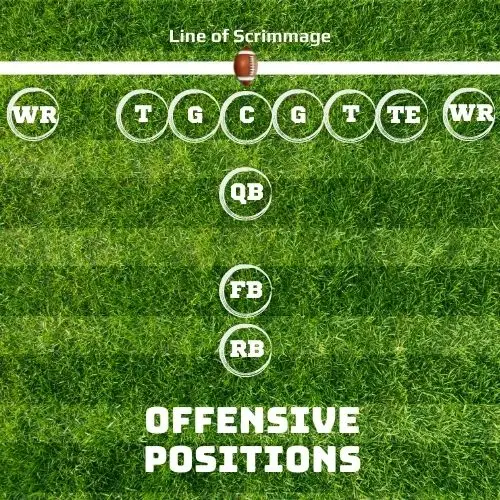
Backfield Offensive Players
Quarterback (QB)
- Behind the Center
- Catches the snap (hike) from the Center at the start of each down
- The boss of the field – he calls it and players do it
Do you hear him like I recall? …mumble that sounds like an auctioneer…hut, hut, hike! He’s actually repeating or calling out strategies and lets the Center known when to snap. - Runs, passes or hands-off the ball, aiming ultimately for a touchdown
- Historically, most known player
- Immense throwing strength and accuracy, as well as extremely fast
Fullback (FB)
- Behind the Front Offensive Line, usually behind the Quarterback and in front of the Running Back
- Often runs up to clear a path for the Running Back or Quarterback
- A beefier version of a Running Back
- Fast
Running Back (RB)
- Also known as Halfback (HB) or Tailback (TB)
- Behind the Front Offensive Line, behind the Quarterback and Fullback
- #1 carrier of the ball on running plays
- Catches forward passes
- Blocks for the Quarterback
- Very Fast
Other Offensive Positions
Wingback (WB)
- Positioned just back and to the outer side of the Tight End
- Type of Running Back, like a more forward Fullback
Slotback (SB)
- Positioned between and slightly back from the slot between Tackle and Wide Receiver
- Also known as A-Back or Slot Receiver
- Like a cross between a Wide Receiver and a Running Back
H-Back (H-B)
- Not the same as Halfback
- Positioned just behind where the Tight End would be
- Like a cross between a Tight End and a Fullback
Defensive Football Positions in Typical Formations
The players on Defense are strategically placed depending where the offense has their players and what positions it appears they’ll be playing. Typically, the front and center spots at the line of scrimmage are manned by 3 or 4 players called the Defensive Line.
The Defensive Line is directly opposing the Offensive Line, so these players need to be the biggest and strongest. Their job is to get through the Offensive Line and tackle to ball carrier to prevent a touchdown.
Since different plays from Offense need to be prepared for, the Defensive Line can have different configurations. Many times, the front four are made up of 2 Defensive Tackles and 2 Defensive Ends, with 3 Linebackers behind. Other times, there is 3 up-front, with 1 Defensive Tackle and 2 Defensive Ends, with 4 Linebackers behind.
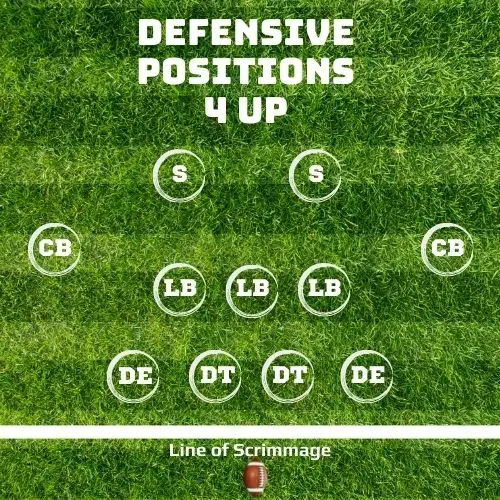
DE-Defensive End, DT-Defensive Tackle, LB-Linebacker, CB-Cornerback, S-Safety
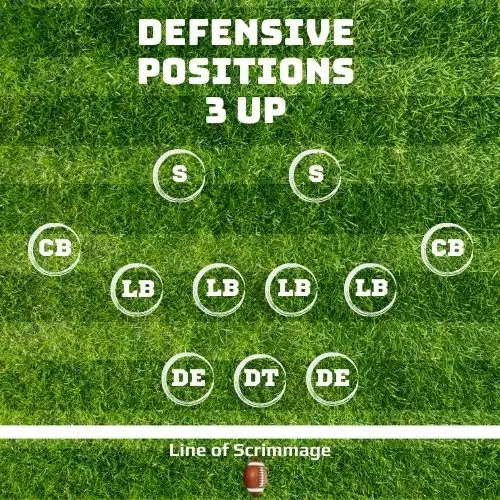
Defensive Tackles (DT)
- Typically, one or two
- Front, middle of the lineup at the line of scrimmage
- Get past the Offensive Lineman and stop the ball carrier from advancing or throwing a pass
- Very big and strong
Nose Guard (NG)
- One
- Same as a Defensive Tackle – used in 3 front formation
- Front, middle of the lineup at the line of scrimmage
- Get past the Offensive Lineman and stop the ball carrier from advancing or throwing a pass
- Very big and strong
Defensive Ends (DE)
- Typically, two
- Front, middle of the lineup at the line of scrimmage
- Outside – left and right of either 2 Defensive Tackle or 1 Nose Guard
- Stop the ball carrier from moving up field and tackle the Quarterback
- Big, strong, and fast
Linebackers (LB)
- If three – Left Outside (LOLB), Right Outside (ROLB), and Middle (MLB)
- If four – 2 Inner (LILB), (RILB) and 2 Outer (LOLB), (ROLB)
I do love how these acronyms look at lot like things I’ve looked up that my teens write in text. It’s probably even more funny that I actually have to look them up…Insert hand slap to face emoji.
- Just back from the Defensive Line
- Between the holes in, and just outside of the Defensive Line
- Tackle ball carrier or rush receiver so he is unable to catch a pass or in order to intercept it
- Strong and fast
Cornerbacks (CB)
- Typically, two
- Behind Linebackers and out to the sides
- Mainly positioned directly against Wide Receivers
- Stop receiver from catching a pass – either with a swat away or interception
- Fastest Defensive player
Sometimes a Cornerback will move up to be more of a 5th acting Linebacker. The player is then called a Nickelback (NB). Makes you wonder if the band really got its name from giving change back at a coffee shop, hmm.
Safeties (S)
- Typically, two – Strong Safety (SS) and Free Safety (FS)
- Behind Linebackers, further back and usually centrally located
- Must be ferocious tacklers, can also swat away a pass or intercept
- Literally the last line of Defense before the End Zone
- Strong and fast
- Fun fact – when I was younger, my best friend would yell ‘safety’ when she passed gas. Those of you with brothers might do the same, she has 3. Look it up! This position makes me think of it every time!!
Special Teams (ST)
These players come onto the field during circumstances that involve kicking the ball.
Kicker (K)
- Kicks the ball for kickoffs and field goals
- Kick from a tee
- Need strong legs and accuracy in kicking
Place Holder (PH)
- Holds the ball for the kicker
Kick Returner (KR)
- Catches and returns kickoffs
Punter (P)
- Kicks the ball to increase yardage needed for the opposing team to score
- Punts usually happen because the offensive team is unable to make their 3rd down and too far to make a field goal
- Uses a drop-kick
- Need strong legs and accuracy in kicking
Long Snapper (LS)
- Snaps the ball to the Punter
Punt Returner (PR)
- Catches and returns punts
My hope is that you’ve now learned just about all there is to know about player positions in football. Configurations are ever-changing, because so are the plays.
Again, these are the basics so that you feel better able to stay in the football discussion and confident to add your own commentary. I hope the visuals helped – they sure do for me! Keep this article handy as a quick reference and share it with your friends so they can do the same!

